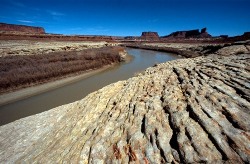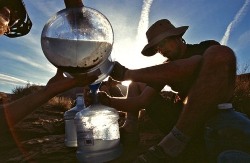
The Manpower Project
Exploring the Canyonlands' backcountry by mountain bike
January 30, 2005

|
| Panoramic view of White Rim trail Photo by Andrew Kornylak |
Nearly eighty years later the march goes on. At the start of the 21st century there are more automobiles per American household than licensed drivers, and a well-planned, well-maintained system of highways covers the nation. Even the "graveled highway" of Leopoldís time would seem quaint and primitive if encountered today.
The idea that some public land should be protected from mechanized development was in its infancy in Leopoldís time. The invasion of the automobile and paved road into the American landscape certainly added urgency to this movement. The term "wilderness" was first officially used by Arthur Carhart in 1920 to designate Trappers Lake in the White River National Forest in Colorado as forever "roadless." The effort to officially protect land from development was further championed by Leopold, then a forester in New Mexico.
Leopold felt that since humans cause destruction of the land, humans ought to be responsible for protecting and preserving it. He was one of the first to voice a purely ethical argument for preserving wilderness, one which remained unpopular until much later.
2001 was a good year for pedal-pushers. That year, the Roadless Area Conservation Rule was issued by the Forest Service in the last days of the Clinton Administration, putting nearly 60 million acres of National Forest land under protection from most logging and road-building. Unlike Wilderness Areas, Roadless Areas would allow mountain biking. For proponents of man-powered recreation, as well as conservationists, it was a huge victory. But the party didnít last long. In the wake of a half-dozen lawsuits by states refusing to follow Federal mandate, George W. Bush suspended the Rule immediately upon taking office. On July 12 of this year, the Forest Service officially overturned the Rule, throwing up its hands and leaving designation of roadlessness as an issue to be lost in state bureaucracies. Those who choose to shun "gasoline and four wheel brakes" in favor of self-propelled forays into the wild can only hope their governer feels the same way.
"Wilderness," said Leopold, "is a resource which can shrink but not grow." Certainly however, there are areas of land that can be reclaimed, where roads can be closed to motorized vehicles, de-emphasizing the imprint of man and encouraging a return to Leopoldís classical definition of wilderness. Such reclaimed areas could support all types of man-powered vehicles, such as mountain bikes, as well as pack animals. These reclaimed roads could still provide a way to get deep into the backcountry, while still providing a wilderness experience. In the deserts of the Southwest, many roads which were built for mining or other resource exploration have been long abandoned or designated for recreational use as jeep trails. With modern biking equipment and sound preparation, many of these roads can be traveled by manpower alone.

|
| Filling up jugs of water Photo by Andrew Kornylak |
In March 2004, I joined four other adventurers, Trent Baker, Chaz Langolier, Devin Close and Zack Pitts, to explore those possibilities first-hand. The objectives of the "Manpower Project" were the summits of four major desert towers, deep in the backcountry of Canyonlands National Park. We would climb all the towers free of direct aid, using our hands and feet to ascend, using ropes and equipment only for safety. The only way to access these towers is via the White Rim Trail, but rather than use the traditional support jeeps, we would carry our own water, food, shelter and climbing gear for the seven-day expedition. It would require nearly 2000 feet of climbing and over 120 miles of backcountry travel by mountain bike and foot. Months of planning followed, and when we met for the first time in Salt Lake, we were all eager to hit the trail.
The first two days of our trip were eye-openers. Within the first five miles from the start of the Trail, we had several flats and a few crashes. We each pulled nearly 80 pounds of food, water and gear, and our overloaded bike trailers threatened to torque us right off the edge of the dizzying road. Any hill we encountered was ghastly work. The flats were brought on by the heat on our wheel rims as we descended thousands of feet of steep switchbacks down to the Colorado River. Luckily we had prepared for this, bringing with us plenty of spare tubes and patch kits. On the second night, after successfully climbing two of the towers, Trent and Chaz lost their way on the descent to camp, and ended up spending a night out in the open without food or water. Rather than panic, they fell back on sound wilderness survival skills to keep warm and find camp the next day.
The next several days proved even more challenging, but potential trouble was averted. We ran low on water after climbing the third tower, but we were able to fetch water from the Green River and boil it. Deep sand hampered our efforts to get to our final objective, five miles off the Trail. We didnít have enough food to stay an extra day in the canyon, so by rising early and carefully planning our meals we were able to climb the tower and still bike out to the rim that night. The final day proved the toughest. We were out of food and water, and what we thought would be flat cruising back to the trailhead turned out to be endless hills and more sand. We pressed on, found an unexpected shortcut, and completed our trip both exhausted and elated.
On the way out, passing the train of jeeps and trucks laden with bicycles and gear queued up for the Trail, we felt we had accomplished something truly special. By being bold in our objectives and committing ourselves to a principle, we had climbed a proud desert-ratís tick-list, biked a fat-tire dream ride, and spent six nights under the naked stars of the southwest desert, all in one trip.
To propel oneself slowly across the still-awesome American wilderness is a profound joy. The window of opportunity for this kind of adventure in our public backyard is still open to anyone, yet it dims and sags with time, neglect, and the "march of empire." Once that window is closed, we may gaze through it and remember, but it will be closed forever.
-- Written by Andrew Kornylak